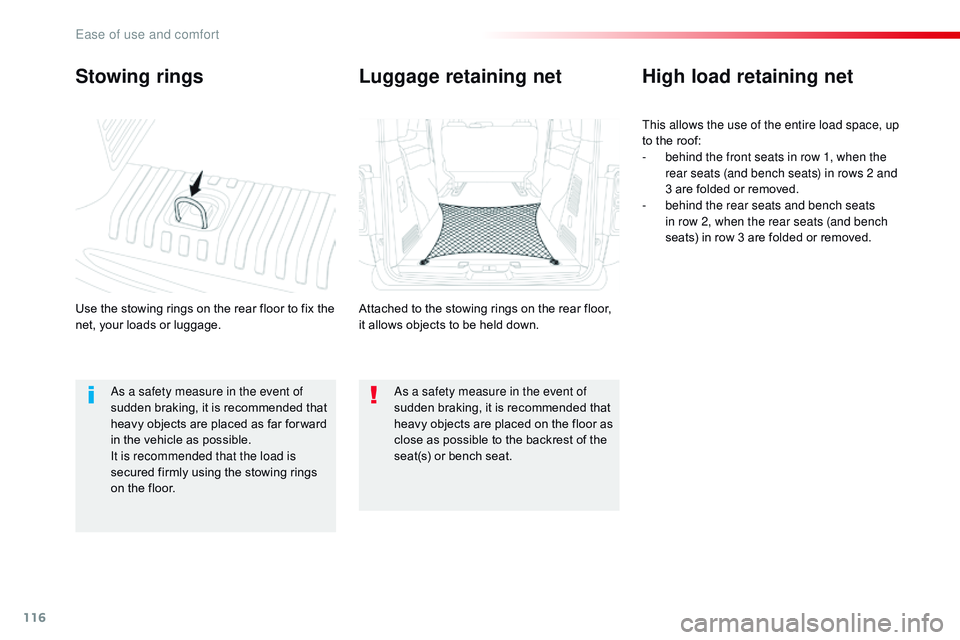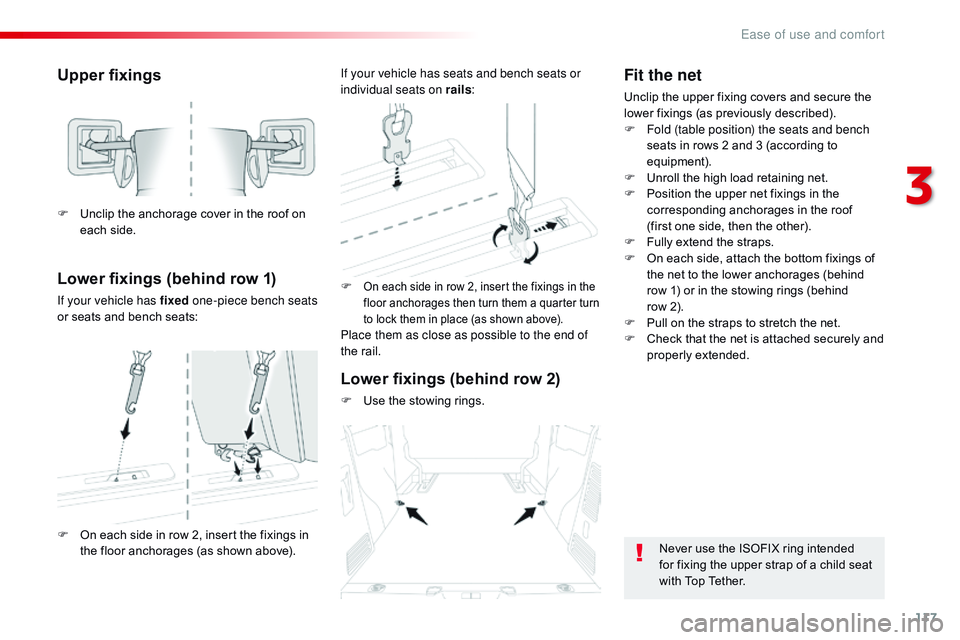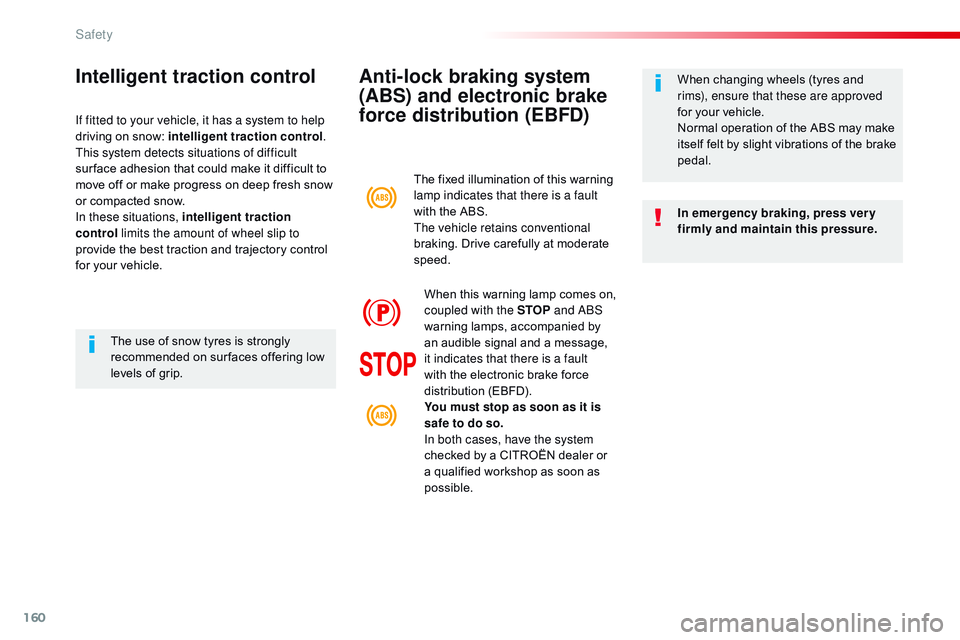ECU CITROEN DISPATCH SPACETOURER DAG 2017 Handbook (in English)
[x] Cancel search | Manufacturer: CITROEN, Model Year: 2017, Model line: DISPATCH SPACETOURER DAG, Model: CITROEN DISPATCH SPACETOURER DAG 2017Pages: 774, PDF Size: 38.33 MB
Page 112 of 774

110
Spacetourer-VP_en_Chap03_ergonomie-et-confort_ed01-2016
Mats
When fitting the mats for the first time, on the
driver's side use only the fixings provided in the
wallet attached.
FittingRemoval
To avoid any risk of jamming of the
pedals:
-
o
nly use mats which are suited to
the fixings already present in the
vehicle; these fixings must be used,
-
n
ever fit one mat on top of another.
The use of mats not approved by
CITROËN may inter fere with access to
the pedals and hinder the operation of
the cruise control / speed limiter.
The mats approved by CITROËN have
two fixings located below the seat.
To remove the mat on the driver's side:
F
m
ove the seat as far back as possible,
F
u
nclip the fixings,
F
r
emove the mat.
Interior fittings
In rows 2 and 3
Refitting
To refit the mat on the driver's side:
F p osition the mat correctly,
F
r
efit the fixings by pressing,
F
c
heck that the mat is secured correctly.
Use the Velcros to fit the transverse mats in row 2
w ith the longitudinal mats in rows 2 and 3.
Ease of use and comfort
Page 117 of 774

115
Spacetourer-VP_en_Chap03_ergonomie-et-confort_ed01-2016
Seating area fittings
Depending on the vehicle's equipment, the various fittings below are located in the seating area.
Strap type grab handleCup holder
(depending on version)
Any liquid carried in an open receptacle (cup
or other) might be spilt, presenting a risk. Take
care.
Nets on the backs of the
front seats
Coat hooks
3
Ease of use and comfort
Page 118 of 774

116
Spacetourer-VP_en_Chap03_ergonomie-et-confort_ed01-2016
Stowing rings
Use the stowing rings on the rear floor to fix the
net, your loads or luggage.
High load retaining net
This allows the use of the entire load space, up
to the roof:
-
b
ehind the front seats in row 1, when the
rear seats (and bench seats) in rows 2 and
3 are folded or removed.
-
b
ehind the rear seats and bench seats
in row 2, when the rear seats (and bench
seats) in row 3 are folded or removed.
Luggage retaining net
Attached to the stowing rings on the rear floor,
it allows objects to be held down.
As a safety measure in the event of
sudden braking, it is recommended that
heavy objects are placed as far for ward
in the vehicle as possible.
It is recommended that the load is
secured firmly using the stowing rings
on the floor. As a safety measure in the event of
sudden braking, it is recommended that
heavy objects are placed on the floor as
close as possible to the backrest of the
seat(s) or bench seat.
Ease of use and comfort
Page 119 of 774

117
Spacetourer-VP_en_Chap03_ergonomie-et-confort_ed01-2016
Upper fixings
Lower fixings (behind row 1)
If your vehicle has fixed one-piece bench seats
or seats and bench seats: F
On each side in row 2, insert the fixings in the
floor anchorages then turn them a quarter turn
to lock them in place (as shown above).
Place them as close as possible to the end of
the rail.
F
U
nclip the anchorage cover in the roof on
each side.
F
O
n each side in row 2, insert the fixings in
the floor anchorages (as shown above). If your vehicle has seats and bench seats or
individual seats on rails
:
Lower fixings (behind row 2)
F Use the stowing rings.
Fit the net
Unclip the upper fixing covers and secure the
lower fixings (as previously described).
F
F
old (table position) the seats and bench
seats in rows 2 and 3 (according to
equipment).
F
U
nroll the high load retaining net.
F
P
osition the upper net fixings in the
corresponding anchorages in the roof
(first one side, then the other).
F
F
ully extend the straps.
F
O
n each side, attach the bottom fixings of
the net to the lower anchorages (behind
row 1) or in the stowing rings (behind
row
2).
F
P
ull on the straps to stretch the net.
F
C
heck that the net is attached securely and
properly extended.
Never use the ISOFIX ring intended
for fixing the upper strap of a child seat
with Top Tether.
3
Ease of use and comfort
Page 120 of 774

118
Spacetourer-VP_en_Chap03_ergonomie-et-confort_ed01-2016
Luggage cover
F Raise it to remove it.
F T o install it, insert the guides into their
housings.
If fitted to your vehicle, the side windows in row 2
c an be opened.
While driving, the window must be closed or
secured at one of the notches.
Windows in row 2
For more information on the Child
lock for rear windows , refer to the
corresponding section. Always guide the blind slowly using the
tab, both up and down.
Side blinds
Fitted to the windows in row 2, they protect the
passenger compartment from the sun's rays.
F
P
ull the tab A and anchor the blind on the
hook B .
F
S
queeze the two controls then move the
window sideways.
Ease of use and comfort
Page 160 of 774

158
Spacetourer-VP_en_Chap05_securite_ed01-2016
Automatic operation of
hazard warning lamps
Hazard warning lamps
When braking in an emergency, depending on
the rate of deceleration, as well as when the
ABS regulation is invoked or in the event of an
impact, the hazard warning lamps come on
automatically.
They switch off automatically the first time you
accelerate.
F
Y
ou can also switch them off by pressing
the button.
Visual warning with all of the direction
indicators flashing to alert other road users to a
vehicle breakdown, towing or accident.
Emergency or
assistance call
This system allows you to make an emergency
or assistance call to the emergency services or
to the dedicated CITROËN service.
For more information on Audio and
telematics and in particular the
use of this equipment, refer to the
corresponding section.
F
P
ress this button, all of the direction
indicators flash.
They can operate with the ignition off.
Safety
Page 161 of 774

159
Spacetourer-VP_en_Chap05_securite_ed01-2016
Electronic stability control (ESC) incorporating
the following systems:
-
a
nti-lock braking system (ABS) and
electronic brake force distribution (EBFD),
-
e
mergency braking assistance (EBA),
-
w
heel anti-slip regulation (ASR) or traction
control,
-
d
ynamic stability control (DSC).
Electronic stability control (ESC)
Definitions
Anti-lock braking system (ABS)
and electronic brake force
distribution (EBFD)
This system improves the stability and
manoeuvrability of your vehicle when braking
and contributes towards improved control on
corners, in particular on poor or slippery road
surfaces.
The ABS prevents wheel lock in the event of
emergency braking.
The EBFD manages the braking pressure
wheel by wheel.
Emergency braking assistance
(EBA)
In an emergency, this system enables you to
reach the optimum braking pressure more
quickly and therefore reduce the stopping
distance.
It is triggered according to the speed at which
the brake pedal is pressed. This is felt by a
reduction in the resistance of the pedal and an
increase in the effectiveness of the braking.
Anti-slip regulation (ASR)
The ASR system (also known as Traction
Control) optimises traction in order to limit
wheel slip by acting on the brakes of the driving
wheels and on the engine. It also improves
the directional stability of the vehicle on
acceleration.
Dynamic stability control (DSC)
If there is a difference between the path
followed by the vehicle and that required by
the driver, the DSC monitors each wheel and
automatically acts on the brake of one or more
wheels and on the engine to return the vehicle
to the required path, within the limits of the laws
of physics.
Horn
F Press the central part of the steering wheel.
5
Safety
Page 162 of 774

160
Spacetourer-VP_en_Chap05_securite_ed01-2016
Anti-lock braking system
(ABS) and electronic brake
force distribution (EBFD)
In emergency braking, press ver y
firmly and maintain this pressure. When changing wheels (tyres and
rims), ensure that these are approved
for your vehicle.
Normal operation of the ABS may make
itself felt by slight vibrations of the brake
pedal.
The fixed illumination of this warning
lamp indicates that there is a fault
with the ABS.
The vehicle retains conventional
braking. Drive carefully at moderate
speed.
When this warning lamp comes on,
coupled with the STOP and ABS
warning lamps, accompanied by
an audible signal and a message,
it indicates that there is a fault
with the electronic brake force
distribution (EBFD).
You must stop as soon as it is
safe to do so.
In both cases, have the system
checked by a CITROËN dealer or
a qualified workshop as soon as
possible.
Intelligent traction control
If fitted to your vehicle, it has a system to help
driving on snow: intelligent traction control .
This system detects situations of difficult
sur face adhesion that could make it difficult to
move off or make progress on deep fresh snow
or compacted snow.
In these situations, intelligent traction
control limits the amount of wheel slip to
provide the best traction and trajectory control
for your vehicle.
The use of snow tyres is strongly
recommended on sur faces offering low
levels of grip.
Safety
Page 163 of 774

161
Spacetourer-VP_en_Chap05_securite_ed01-2016
Dynamic stability control (DSC)
and anti-slip regulation (ASR)
Activation
These systems are activated automatically
each time the vehicle is started.
As soon as they detect a problem of grip or
trajectory, these systems act on the operation
of the engine and brakes.This is indicated by flashing of this
warning lamp in the instrument panel.
Deactivation
In exceptional conditions (starting a vehicle
which is bogged down, stuck in snow, on soft
ground...), it may be advisable to deactivate
the DSC system, so that the wheels can move
freely and regain grip.
But it is recommended that the system be
reactivated as soon as possible.
Operating fault
Reactivation
F Press this button. F
T
urn the knob to this position.
Or
The indicator lamp in the button or the knob
comes on: the DSC system no longer acts on
the operation of the engine. The system is reactivated automatically each
time the ignition is switched back on or from
30
mph (50 km/h).
However, below 30 mph (50 km/h) you can
manually reactivate the system. F
P
ress this button.
Or
F
T
urn the knob to this position.
The indicator lamp in the button or the knob
goes off. The DSC system offers exceptional
safety in normal driving, but this should
not encourage the driver to take extra
risks or drive at high speed.
The correct operation of the system
depends on observation of the
manufacturer's recommendations
regarding the wheels (tyres and rims),
the braking components, the electronic
components and the CITROËN
assembly and repair procedures.
After an impact, have the system
checked by a CITROËN dealer or a
qualified workshop.If this warning lamp comes on,
accompanied by an audible signal
and a message in the screen, this
indicates a fault with the system.
Contact a CITROËN dealer or a qualified
workshop to have the system checked.
5
Safety
Page 164 of 774

162
Spacetourer-VP_en_Chap05_securite_ed01-2016
Grip control
Special patented traction control system which
improves traction on snow, mud and sand.
This system, the operation of which has been
optimised for each situation, allows you to
manoeuvre in most conditions of poor grip
(encountered during touring use).This mode is calibrated for a low level of wheel
spin, based on the different levels of grip
normally encountered on the road.
F
P
lace the knob in this position.This mode adapts its strategy to the conditions
of grip encountered for each of the two front
wheels on moving off.
(mode active up to 30 mph (50 km/h))
F
P
lace the knob in this position.
A five-position selector knob allows you to
choose the setting best suited to the driving
conditions encountered.
An indicator lamp associated with each mode
comes on to confirm your choice. The accelerator pedal should be pressed
sufficiently to allow the system to use the power
of the engine. Operation at high engine speeds
is completely normal. Different modes are provided:Snow
Standard (ESC)
Every time the ignition is switched off,
the system automatically resets to this
mode.
Associated with all-seasons Peak
Mountain Snow Flake tyres, this system
offers a compromise between safety,
adhesion and traction. These tyres work
equally well in winter and summer.
Safety